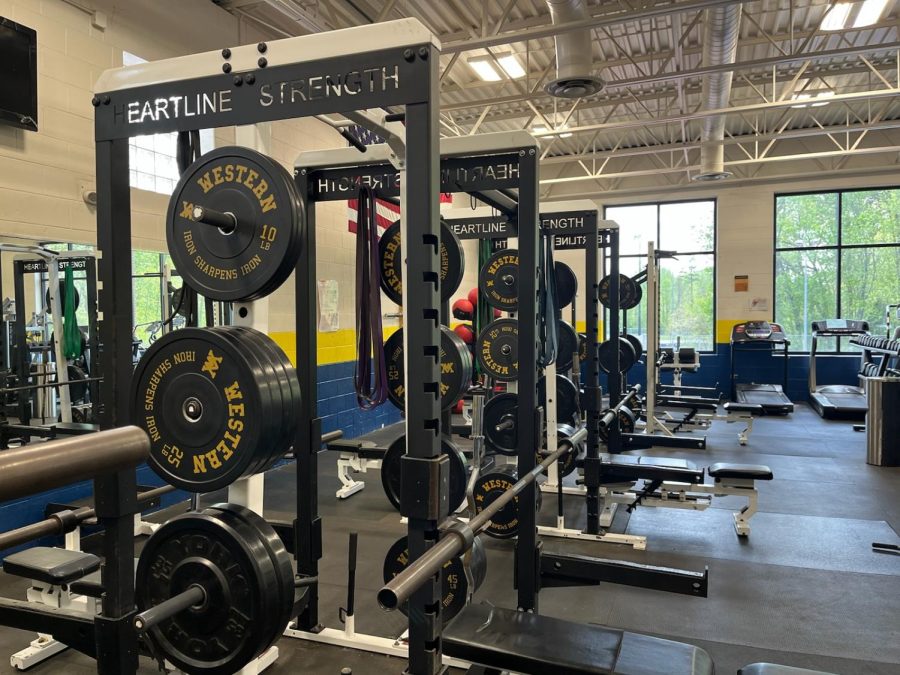Just Tryin’ to Get Big
What’s behind the gym-culture trend?
Credit: Sophie Mathew
While society portrays young women as the main victims of body image disorders, it is not a gendered issue. In light of the pandemic, men have experienced increasing pressure to conform to male beauty standards influenced by unrealistic expectations seen in popular media. Many won’t seek help or speak up due to stereotypical or internal beliefs. The trends that give rise to this desire for a muscular and lean body often lead to a disorder dubbed “bigorexia.”
“Bigorexia” is the belief that men are supposed to project strength and self-reliance. This term is used to describe the obsessive desire to have bigger muscles. It is often distinguished by unrestricted weight lifting, low self confidence, or insecurities. Local gyms have seen a rise in the weight room, which poses the question, “What’s behind the trend of weightlifting in high school?”
There is no harm in weightlifting itself. People who do muscle strength training are less likely to die prematurely from cancer and heart disease. Just 30 to 60 minutes a week could be enough to decrease this risk. Weightlifting exercises are also used to develop strong bones. While aiding physically, weightlifting also improves the mental state of people by sharpening thinking skills and increasing serotonin levels. In fact, most pursue it because of the extensive benefits.
Sophomore Dan Diamond decided to fill his free time in the summer in a positive way, by lifting. He plans his weekly regime, aiming to lift four to six times a week. He hits each muscle group twice a week and combines muscle groups into certain days.
“I make sure I follow the routine by the day. So today for example, I have to hit legs and then on Sunday I have to do chest, shoulders, and triceps,” Diamond said. His goal was to look better and feel better about himself. To ensure he stays healthy, Diamond does not take supplements, instead consum- ing most of his protein through shakes and meat. Now, Diamond says, “I just enjoy working out more than actually looking like I work out.” However he felt that the pressure “can definitely be negative sometimes. With social media, you’re looking at people who are on steroids.” Diamond’s advice is to remember where you started from, your progress, and as long as you have a good mentality, your goals are achievable.
Weightlifting also helps in other sports. Abe Maybee first started lifting with his fellow sophomore Diamond last summer to keep in shape during the off season. Maybee noted that the benefits of lifting have helped him improve in soccer. “I was able to stay on my feet, keep my footing, and move people up the field better,” he said.
Maybee maintains a healthy relationship with weightlifting by focusing on the improvement aspect and working towards specific goals. His motivation is driven by both long term and short term rewards; feeling and looking healthier and better and an increase in confidence. After a workout, he takes whey protein with milk for muscle recovery. He balances his diet by retaining a good protein intake and staying away from supplements, such as creatine. Maybee felt that taking supplements would create an unhealthy relationship with lifting.
“I don’t think I’d want to be that big,” Maybee added. “I don’t think I’d look as healthy, I don’t think I’d be as good at soccer and my mental health wouldn’t be as good cause at that point it becomes an obsession and it consumes you, so I just don’t wanna go down that rabbit hole.”
Similarly, junior Parker Voorhees started weightlifting to improve as a football player and stayed because of what he describes as an intoxicating pull. “It’s the pump honestly. I’m just a pump junkie.” Juggling two varsity sports, Vorhees is still able to nourish himself suitably. “My parents are exercise physiologists so they know what they’re doing.”
What about steroids?
The real danger of lifting comes from young men who are unaware of the damage steroids can do and who fail to consider the side effects before starting a cycle. A ‘cycle’ involves taking multiple doses of steroids over a specific period of time.
Steroids give athletes an edge in athletic performance that often goes unnoticed. In many schools drug testing is not allowed. Athletic Director Steve Heon discussed Western’s policy on student athletes and drug usage. “We have a code of conduct. Albemarle County does so specifically with drugs and alcohol, but also steroids. Performance enhancing drugs are forbidden in the Virginia High School League. They also have a no steroid policy as well.” In regards to the reasoning as to why schools in Albemarle County can’t administer drug tests, Heon said, “It’s a county policy that was put in place for privacy. It’s a privacy issue.”
A significant number of schools don’t have a formal program centered around fostering a body-positive environment, so it is up to coaches and teachers to disprove the need for enhancements and screen for substance abuse. Heon described the major indications of substance abuse as, “erratic behavior but there can be physical signs as well, body changes that appear to be tight and quick show the signs of potential steroid use.” These factors are hard to detect and would require the close inspection of students. “If we have reason for concern we would want to help the individual and pull in counseling to help us understand the reason behind the substance abuse,” Heon said.
Selective Androgen Receptor Modulators, known as SARMS, are the most commonly used and easily attainable option used by athletes to stimulate anabolism, which increases strength and muscle mass, and the recovery process in exercise. SARMS distinguish themselves from other steroids because they attach to specific, desirable cells, which decreases the risk of unwanted effects in other cells, such as the production of inflammatory chemicals. These drugs are illegal to buy and sell. Organizations such as the Food and Drug Administration have recently banned the marketing of SARMS as dietary supplements.
SARMS are not classified as dietary supplements because of the life threatening reactions they induce: Osteoporosis, cancer, heart failure, and liver disease are just some of the few side effects accompanied by the usage of steroids. Users often find that they experience severe mood swings and increased amounts of acne.
One Western senior, John*, who wishes to remain anonymous, stated his interest in steroids came from curiosity; how quickly they would work? What were the before and after results? He researched steroids for seven months before settling on a specific steroid, Ligandrol 4033 SARM. While Doe did not complete a full cycle, only doing four weeks, he noticed a short term change.
“I still noticed a slightly bulkier yet less fatty physique and some strength gain.” He added that the effects of the steroid helped in the short term but ultimately did not produce the desired effect long term. “It did not help as much as I anticipated, but I only did it for half the time a normal cycle goes.” As to his cycle, Doe stated “I don’t have the most positive view on SARMS. They cause a lot of spurts of rage/anger and you can get triggered very easily.”
Regarding the future, Doe said he might try another cycle in a few years as he only continued the cycle for half the recommended time, four weeks.
Psychologists are quick to blame the influence of social media for circulating unrealistic images that men consume. A justified argument considering the harmful effects of common media. Checking apps like Instagram or Tik Tok causes a surge of instant gratification. This addictive rush of dopamine can bring about depression, anxiety, loneliness and body image concerns. Thus, comparing and trying to imitate the bodies of influencers and celebrities is harmful. It creates the unachievable expectation that anyone can obtain the ‘ideal’ body if they work hard enough. This idea leads to unhealthy feelings of shame, isolation, depression, anxiety, problems with sleeping, eating, and maintaining relationships. Yet sometimes, this line of thinking can lead to the consumption of dietary supplements and potential substance abuse. Protein powder is not inherently bad for you and can be a convenient source of protein. But there are people that add steroids to these supplements to increase the wanted effect. These factors make steroids, pre-workout energy drinks, and other additives incredibly alluring to many young boys struggling with self image issues.
Muscular bodies have long been praised, and coupled with the performative nature of social media, it now creates a toxic environment. Unfortunately, the need for help has not yet surpassed the fear of asking. However, the future looks hopeful with the newfound spotlight on mental health and body-positivity.
*Some names were changed in order to protect the anonymity of students.
Your donation will support the student journalists of Western Albemarle High School. Your contribution will allow us to purchase equipment and cover our annual website hosting costs.

Sophie is a senior at Western in her third year of journalism. This year she is an Editor-in-Chief and is excited for this new role. She is on the crew...












